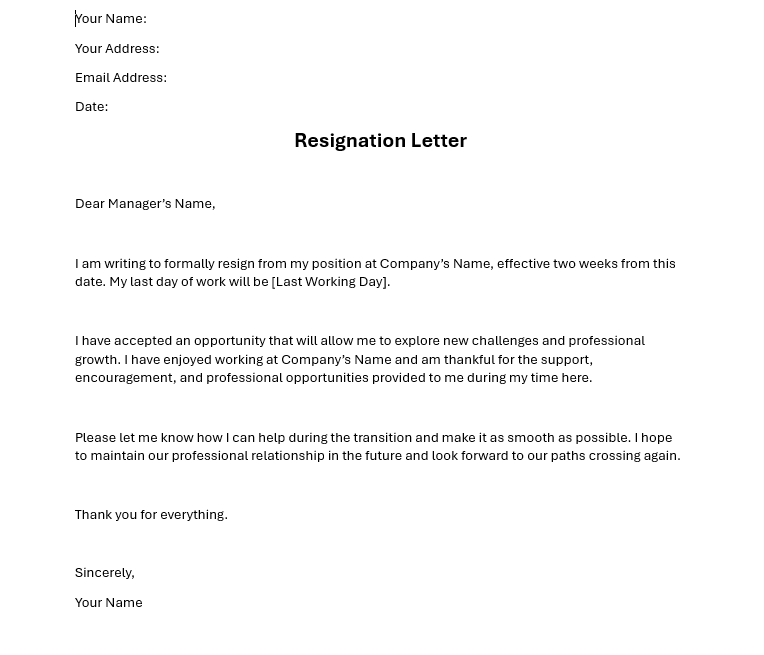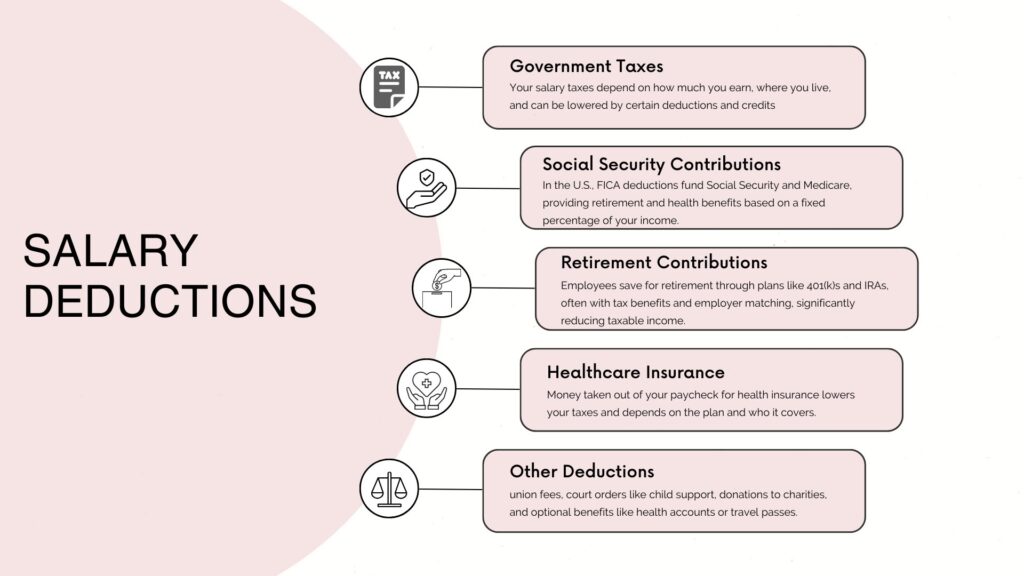Resigning from your job is a significant career move that requires tact and professionalism. It’s crucial to handle this transition gracefully, ensuring you leave on good terms and maintain positive relationships with your former employer and colleagues. Crafting a well-thought-out resignation letter is a key step in this process. Here’s an expanded guide on what to include in your resignation letter, with a detailed sample letter to inspire your own.
What to Include in Your Resignation Letter
Your resignation letter should be concise yet thoughtful, effectively communicating your intentions while maintaining a tone of respect and professionalism. It is important that the letter covers several key points to ensure a smooth transition and to leave a positive impression. Here’s what to include:
Notification of Resignation and Final Working Day
Begin your letter by stating clearly your current position, your decision to resign, and the date of your last day. This direct approach does not require extensive explanations but should convey the necessary information succinctly and professionally.
Subject: Notification of Resignation
Dear [Supervisor’s Title and Name],
I am writing to formally notify you of my resignation from my position as [Your Position] at [Company Name]. Please accept this letter as official notice, adhering to the required two-week notice period. My last working day will be [Last Working Day, e.g., “Friday, two weeks from today”].
Thank you for your understanding.
Sincerely,
[Your Name]
Expression of Gratitude
Reflect on your tenure and acknowledge the opportunities and experiences that have contributed to your professional growth. Expressing gratitude, regardless of your reasons for leaving, underscores your professionalism and leaves a lasting positive impression.
Subject: Expression of Gratitude
Dear [Supervisor’s Title and Name],
As I prepare to move on from my role at [Company Name], I want to express my sincere gratitude for the myriad of opportunities I’ve encountered during my tenure here. The diverse projects I’ve engaged in have significantly enriched my professional skills and deepened my enthusiasm for our field. Working alongside a team characterized by dedication and excellence has been truly inspiring and immensely beneficial.
Thank you for the incredible experiences and for your pivotal role in my career development.
Warm regards,
[Your Name]
Commitment to a Smooth Transition
Offer specific details about how you plan to ensure a smooth handover of your responsibilities. This part of your letter shows your commitment to the company’s continued success, even as you prepare to leave.
Subject: Subject: Commitment to a Smooth Transition
Dear [Supervisor’s Title and Name],
As I approach my final days at [Company Name], I am fully dedicated to ensuring a smooth and effective handover of my duties. Over the next two weeks, I will prioritize the completion of all pending projects and prepare comprehensive transition documents for my successors. I am also available to provide in-depth training to any team members who will be assuming my responsibilities.
Please feel free to reach out if there are any other areas where you believe my assistance could be beneficial during this transition period.
Best regards,
[Your Name]
Positive Closing and Future Relations
Conclude your letter on an optimistic note, expressing your hopes for the company’s future and your intention to maintain a professional connection.
Subject: Wishing Continued Success
Dear [Supervisor’s Title and Name],
As I close this chapter at [Company Name], I look forward with optimism to the company’s ongoing success and expansion. I hope to sustain our professional relationship and remain open to future collaborations. I am deeply thankful for the opportunities and support provided during my time here, which have laid a solid foundation for the next phase of my career.
Thank you once again for everything. I look forward to staying in touch and possibly working together again in the future.
With warm regards,
[Your Name]
What Not to Include in Your Resignation Letter
When writing a resignation letter, it’s important to keep it professional and concise, focusing on the necessary details without including inappropriate or unnecessary information. Here are some key things to avoid in your resignation letter:
Negative Comments about the Company or Employees: Avoid any negative remarks about your colleagues, supervisors, or the organization. It’s important to leave on a positive note to maintain professional relationships.
Specific Complaints or Criticisms: If you have grievances, a resignation letter is not the right place to air them. Keep your letter neutral and professional.
Too Much Detail on Why You’re Leaving: It’s not necessary to explain in detail why you are leaving the job, especially if the reasons are personal or negative.
Details about Your New Job: There’s no need to mention where you are going next or what your new role will be. This can be seen as tactless or insensitive.
Emotional Statements: Keep the tone of your letter formal and factual. Emotional outbursts or sentimental reflections may seem unprofessional.
Salary or Contract Details: Discussing salary or contract issues should be done in person or through appropriate channels, not in a resignation letter.
Threats or Ultimatums: Even if you are leaving under contentious circumstances, avoid any language that could be construed as threatening or coercive.
By avoiding these elements, your resignation letter will reflect professionalism and maintain good relations with your soon-to-be former employer. It’s best to focus on the positive experiences and growth opportunities you had during your tenure and express gratitude for them.
Resignation Letter Samples
Each template focuses on the essential elements of a graceful resignation: gratitude for the opportunity, details of your departure, and an offer to assist during the transition period. Use this Word sample as a starting point to personalize your message and leave a lasting positive impression with your soon-to-be former employer.

Example 1: Standard Resignation Letter
[Your Name]
[Date]
Dear [Manager’s Name],
I am writing to formally announce my resignation from [Company’s Name], effective two weeks from today, [Last Working Day]. This decision was not easy and took a lot of consideration. However, I have accepted a position that will further my career growth and professional development.
I want to express my gratitude for the opportunities I have been given at [Company’s Name] and the professional guidance and support from you and my colleagues. I have greatly enjoyed working here and appreciate all the learning and growth opportunities.
During my final two weeks, I am committed to making the transition as smooth as possible. I am prepared to assist in training my replacement and will ensure that all my reports and responsibilities are up to date before my last day of work.
Thank you once again for the opportunity to be a part of [Company’s Name]. I look forward to staying in touch, and I hope to cross paths again in the future.
Sincerely,
[Your Name]
Example 2: Short and Simple Resignation Letter
[Your Name]
[Date]
Dear [Manager’s Name],
Please accept this letter as my formal resignation from [Company’s Name], effective [Last Working Day], two weeks from today. I am grateful for the valuable experiences and opportunities that I have gained while working with you and have enjoyed my tenure at the company.
I am committed to ensuring a seamless transition and will do everything possible to hand over my responsibilities before my departure.
Thank you for the support and opportunities over the past [duration at the company].
Best regards,
[Your Name]
Example 3: Resignation Letter for Retirement
[Your Name]
[Date]
Dear [Manager’s Name],
I am writing to formally announce my retirement from [Company’s Name], effective [Date of Retirement]. After [number] years of service, I have decided to step down and focus on my family, health, and personal projects.
I have enjoyed my tenure at [Company’s Name], and I am profoundly grateful for the opportunities to grow both personally and professionally. Working alongside such a talented team and contributing to the company’s goals has been a high point of my career.
Please let me know how I can assist during the transition period. I am happy to help train my successor and ensure a smooth and effective handover.
Thank you once again for the opportunity to work at [Company’s Name]. I am looking forward to this new chapter in my life but will always cherish my experiences with the company.
Warm regards,
[Your Name]
Example 4: Resignation Letter for Personal Reasons
[Your Name]
[Date]
Dear Manager’s Name,
I am writing to inform you of my decision to resign from my position at Company’s Name, due to personal reasons, with my final working day being [Date, typically two weeks from the date of the letter].
This was not an easy decision and took a lot of consideration. However, I need to prioritize my health and well-being at this time.
I would like to express my gratitude for the opportunities for professional and personal development that you have provided me during my time here. I have enjoyed working for the company and appreciate the support provided during my tenure.
Please let me know if I can assist in any way to facilitate a smooth transition, including helping to recruit and train my replacement.
Thank you for understanding.
Best regards,
[Your Name]
Example 5: Resignation on Short Notice
[Your Name]
[Your Address]
[Date]
Dear [Manager’s Name],
I am writing to formally resign from my position as [Your Position] at [Company’s Name], effective immediately. I regret that, due to unforeseen circumstances beyond my control, I am unable to provide the standard notice period.
I sincerely apologize for any inconvenience my sudden departure may cause to the team and the ongoing projects. I have thoroughly enjoyed working with you and the team and am grateful for the opportunities to grow both personally and professionally.
I am committed to assisting in the transition of my duties and responsibilities as much as possible during this time. I am available to help train my replacement and provide support in documenting my current projects to ensure a smooth handover.
Thank you for your understanding and support during this difficult time. I hope to leave on amicable terms and wish everyone at [Company’s Name] continued success. I hope to keep in touch in the future.
Warm regards,
[Your Name]
Example 6: Resignation for Further Education
[Your Name]
[Date]
Dear [Manager’s Name],
I am writing to formally announce my resignation from my position at [Company Name], effective [Last Working Day, typically two weeks from the date of this letter]. This decision comes after much consideration, as I have been offered an opportunity to further my education in [Field of Study] at [University/Institute Name], starting [Date].
Pursuing further studies has always been a goal of mine, and I am eager to advance my knowledge and skills in a field that I am deeply passionate about. I believe that this new chapter will not only enrich my professional capabilities but also open new avenues for future collaborations between us.
I want to express my sincere gratitude for the opportunities I have been given at [Company Name]. Working under your leadership has been incredibly rewarding, and the experiences I have gained have played a pivotal role in my professional growth. I am particularly thankful for [Mention any specific projects, skills learned, or support received from colleagues or management].
During my remaining time, I am committed to ensuring a smooth transition. I will diligently work to complete my current projects and pass on my responsibilities to whomever you deem fit. Please let me know how I can further assist during this transition period.
I hope to keep in touch, and I look forward to exploring potential ways we might continue to collaborate in the future. Thank you once again for your understanding and support.
Warm regards,
[Your Name]
Example 7: Resignation Due to Relocation
[Your Name]
[Date]
Dear [Recipient Name],
I am writing to formally announce my resignation from my position at [Company Name], effective two weeks from today, [Last Working Day]. This decision comes after much consideration and is prompted by my upcoming relocation to [New City/State], where I will be moving to support my partner’s career.
It is important to me to express that my decision to leave is solely due to geographic constraints and not out of any dissatisfaction with my role or the company. On the contrary, my experience at [Company Name] has been incredibly rewarding and enriching. I have enjoyed working under your guidance and being part of a team that consistently strives for excellence and innovation.
During my time here, I have learned a great deal and appreciated the opportunities for professional and personal development that you provided. The support from you and the team has been a crucial part of my growth, and I am deeply grateful for the experiences I have gained.
I am committed to ensuring a smooth transition and will do everything in my power to hand over my responsibilities effectively. I am happy to assist in the training of my replacement and will ensure that all my tasks are up to date before my departure.
Please let me know how I can help during this transition. I hope to maintain our professional relationship and keep in touch in the future.
Thank you again for the opportunity to be a part of [Company Name]. I am looking forward to this next chapter in my life but will always cherish my time at the company and the relationships I’ve built here.
Warmest regards,
[Your Name]
Example 8: Resignation Due to Unresolved Issues at Work
[Your Name]
[Date]
Dear [Manager’s Title],
I am writing to formally announce my resignation from [Company Name], effective two weeks from today, [Last Working Day]. This decision has not been easy and reflects my desire to advance my career and explore new opportunities.
I want to express my gratitude for the opportunities I have had during my time with the company. I have grown professionally and personally, and I value the experiences and knowledge I’ve gained.
Please let me know how I can help during the transition and pass on my responsibilities effectively. I hope to ensure a smooth and seamless transition for the team and the company.
Thank you again for the opportunities for professional and personal development that you have provided me during my time at [Company Name]. I look forward to staying in touch, and I hope to cross paths again in the future.
Sincerely,
[Your Name]
How to Write a Subject for Resignation Email
When writing a subject line for a resignation email, it’s essential to keep it straightforward and professional. The goal is to clearly convey the purpose of the email without being overly detailed or emotional. Here are a few examples of suitable subject lines for a resignation email:
Simple and Direct:
- Resignation – [Your Full Name]
- Notice of Resignation Effective [Last Working Day]
Slightly More Detailed:
- Resignation Notice from [Your Full Name]
- Formal Resignation Effective [Date]
Respectful and Formal:
- Submission of Resignation – [Your Full Name]
- Voluntary Resignation – Effective [Date]
If Specificity is Required:
- Notice of Resignation – [Your Full Name] – [Department/Position]
- Resignation Announcement from [Your Position]
Choose a subject line that aligns with the tone of your email and the norms of your workplace. A clear and professionally crafted subject line ensures that your email is taken seriously and handled appropriately.
Resignation in Remote and Hybrid Work Environments
Resigning from a position within a remote or hybrid work setting presents unique challenges and opportunities. Here are some tailored tips to handle the resignation process smoothly in these environments:
Communicate Clearly and Professionally
- Use Video Calls: Whenever possible, communicate your resignation through a video call rather than email. This personal touch can help maintain strong relationships and convey respect to your employer and colleagues.
- Be Prepared: Have a clear script or key points ready for your conversation to keep it professional and focused.
Plan the Return of Company Equipment
- Coordinate with IT: Contact your IT department to understand the process for returning any company equipment such as laptops, phones, or other devices. Ask about shipping labels, packaging standards, and whether they will provide materials for secure shipping.
- Record Serial Numbers: Keep a record of all items and their serial numbers that you are sending back. This can help avoid any discrepancies or claims of missing equipment.
Transfer Knowledge and Documents Efficiently
- Digital Handover: Ensure all your work files, documents, and ongoing project details are organized and accessible in shared drives or company cloud storage. Leave detailed notes or guides for your successor or team.
- Schedule Handover Meetings: Arrange virtual meetings with the team or individuals taking over your responsibilities. Use these sessions to walk them through processes, client details, and where to find essential information.
Organize a Virtual Farewell
- Plan a Virtual Goodbye Party: Organize a virtual farewell party with your team. Coordinate a time that works for everyone and consider using platforms like Zoom or Google Meet for a video call.
- Personalized Messages: Send personalized thank you emails or messages to colleagues and managers. Expressing gratitude can help leave a lasting positive impression.
Update Your Digital Presence
- Email Forwarding: Set up email forwarding if allowed, or create an out-of-office message that includes the contact information of the person taking over your duties.
- Professional Networks: Update your professional profiles such as LinkedIn with your end date and start making connections relevant to your next role or industry.
Secure References and Maintain Networks
- Request References: Before leaving, ask for written references from your supervisors or colleagues, which can be useful for your future endeavors.
- Keep Networking: Continue to engage with your former colleagues and industry contacts through social media and professional networking events. Staying connected can open up future opportunities and collaborations.
Handle Sensitive Information with Care
- Confidentiality: Be mindful of any confidential information you may have had access to. Ensure that all such data is handled according to company policy even after your departure.
By following these tips, you can ensure a professional and smooth transition out of a remote or hybrid work setting, preserving relationships and maintaining a good reputation within your professional network.
Legal Considerations When Resigning
When you decide to resign from your job, understanding the legal aspects of your departure is crucial to ensure that you fulfill all obligations and protect your rights. Here’s what you need to consider:
Non-Compete Clauses
- Scope and Validity: Check if you have signed a non-compete agreement. These clauses can restrict where you can work after leaving your current job, often based on geographic location and time. Ensure you understand the scope to avoid legal consequences.
- Enforceability: Non-compete clauses are not enforceable in all states or situations. For example, California generally does not enforce non-compete agreements except in very specific circumstances. Consult with a legal professional to understand the enforceability of such clauses in your context.
Severance Packages
- Eligibility and Negotiation: Understand if you are eligible for a severance package based on your company’s policy or your employment contract. If you are eligible, be clear on what is offered and under what conditions. You might also have room to negotiate your severance terms.
- Legal Rights: Be aware of your rights regarding severance pay. In some cases, these rights can be dependent on the reason for termination and the terms laid out in the employment agreement.
Final Paychecks
- Timeliness of Payment: Each state has different laws regarding when a final paycheck must be issued by an employer after an employee resigns. For instance, some states require immediate payment, while others may allow up to the next scheduled payday.
- Inclusions in Final Paycheck: Ensure that your final paycheck includes pay for all worked hours and accrued vacation or paid time off, as per state law and company policy.
Health Insurance and Benefits
- COBRA: Under the Consolidated Omnibus Budget Reconciliation Act (COBRA), you may have the right to continue your health insurance coverage after leaving your job. Check how long the coverage lasts and what it will cost you.
- Other Benefits: Understand the status of other benefits such as life insurance, retirement accounts, or unused benefits like health savings accounts (HSAs). Transfer or rollover options should be clearly outlined.
Returning Company Property
- Legal Obligations: Be sure to return all company property, including laptops, phones, and keys, as failing to do so can result in legal issues or deductions from your final paycheck.
- Documentation: Keep records of what and when you returned items to avoid disputes.
Document Review
- Employment Contract and Handbook: Review your employment contract and employee handbook for any other legal obligations or rights that pertain to your resignation, such as notice periods and confidentiality agreements.
- Legal Advice: Consider seeking advice from a legal professional to review any documents or agreements, especially if you feel unsure about the terms and implications.
By addressing these legal considerations, you can ensure a smoother and more informed transition from your current employment, while safeguarding your interests and complying with legal requirements.
Frequently Asked Questions About Resigning
How should I handle a counter-offer from my current employer?
Consider the reasons you decided to resign initially. If they include factors beyond salary, such as job satisfaction, company culture, or career growth, a counter-offer may not resolve these underlying issues. Evaluate the offer objectively and decide whether it truly aligns with your long-term career goals and personal values.
What should I expect during an exit interview?
Exit interviews are conducted to gather feedback on your experience with the company. Be honest yet professional, focusing on constructive feedback rather than personal grievances. Use this opportunity to discuss your reasons for leaving in a manner that is beneficial for the company’s growth and keep the tone positive and professional.
Is it necessary to provide a detailed reason for resigning?
You are not obligated to provide a detailed explanation of why you are leaving. A simple statement that you are leaving to pursue other opportunities is sufficient. If pressed, you can mention looking for new challenges or growth opportunities, but always keep the details general and professional.
How do I resign if I don’t have another job lined up?
Handle your resignation as you would under any other circumstance: with professionalism and courtesy. Ensure that your resignation letter is respectful, and that you fulfill any required notice period. Explain that you are leaving to explore new opportunities or for personal reasons, as appropriate.
What is the best way to communicate my resignation?
Ideally, resignations should be communicated in person, followed by an official resignation letter. If an in-person meeting isn’t feasible, especially in remote settings, arrange a video call. Always follow verbal communication with a written notice to maintain professionalism.
How can I ensure a smooth handover of my duties?
Document your current projects, responsibilities, and processes. Arrange meetings with your successor or team members to walk them through ongoing tasks. Provide notes, contacts, and any other resources that will help them continue your work effectively.
Should I stay in touch with my former colleagues and employer?
Maintaining a professional network is beneficial for future career opportunities and professional growth. Staying in touch can be done through LinkedIn or other professional networking events. Keep interactions positive and professional.
What if I am asked to leave immediately after resigning?
Some companies might opt to end employment sooner than the notice period, especially in sensitive roles. Prepare for this possibility by organizing your workspace and fulfilling pending tasks ahead of your resignation. Ensure you understand your rights regarding final pay and benefits.
How do I handle my emotions when resigning?
Resigning can be emotionally challenging. Prepare yourself mentally and keep the conversation focused on the professional aspects of your decision. Acknowledge the relationships you’ve built and express appreciation for the opportunities you’ve had.
Conclusion
In conclusion, resigning from a position is a major decision that requires careful consideration and strategic planning. By crafting a professional and respectful resignation letter, you can ensure a smooth transition and maintain positive relationships with your former employer and colleagues. This guide provides comprehensive insights and templates to help you navigate the resignation process with grace, whether you’re leaving for personal reasons, career advancement, or other opportunities.
Remember, the key to a successful resignation lies in clear communication, expressing gratitude for the opportunities provided, and committing to an organized handover of responsibilities. Additionally, understanding the legal aspects of your resignation is crucial to protect your rights and fulfill any contractual obligations. Whether you’re working in a traditional, remote, or hybrid environment, these principles hold true and will guide you in leaving a positive and lasting impression.



































